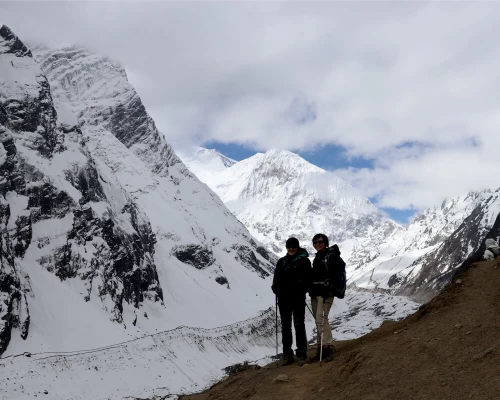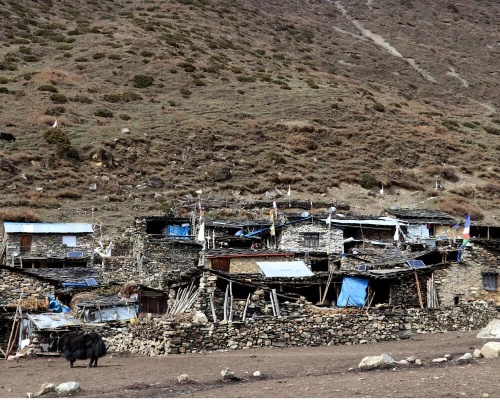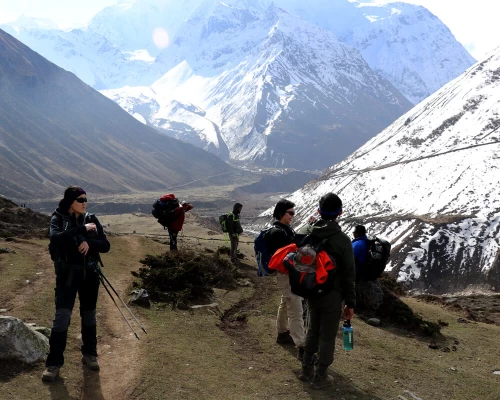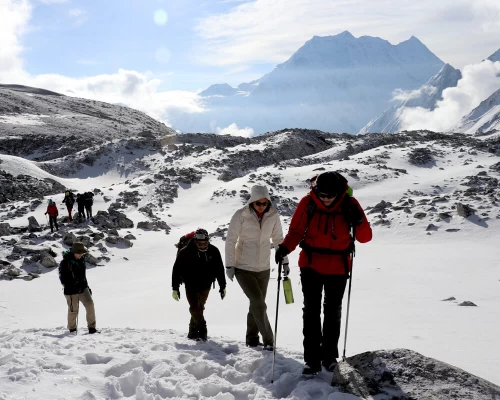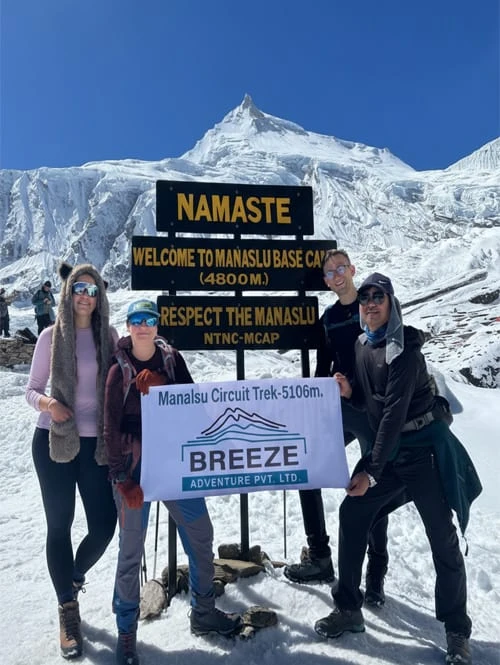Our Manaslu Tsum Valley Trek is a wonderful combination of two treks: The Manaslu Circuit Trek and Tsum Valley Trek. Neither of these trails is heavily trafficked, and in fact, they are two of the more underrated treks in the country. The combination makes for a 23-day excursion into the precious Hidden Valley of Tsum and around the pristine Manaslu(8,156 meters/26,758 feet) – the 8th tallest mountain in the world.
This journey has it all – terraced hillsides, raging rivers, mountain settlements, alpine passes, and of course, huge snow-clad mountains. If you look at a map of the ManasluTsum Valley Trek, you will see that the trail is nestled between two popular trekking spots: the Annapurna Conservation Area and Langtang National Park. However, this trail, particularly Tsum Valley, has a unique, almost untouched feel to it.
Overview of the Tsum Valley Trek
The trek begins in Tsum Valley with a head up from SotiKhola, following the turquoise Budi Gandaki River northward. The cool breeze makes us feel at peace, though inside we are so excited for each day to come. From Jagat, we enter Tsum Valley, and we are already surrounded by mountains. Upon arrival there, trekkers feel as if they have entered a truly Hidden Valley, existing outside of time. During our time in the valley, we will stay with the Tsum people, who practice Tibetan Buddhism. Admire their mani stones, wavering prayer flags, and ornate monasteries. Following the Shyar River, we leave the fertile valley to get an up-close view of the mountains at Mu Monastery. The Tsum Valley is a magical place, teeming with spiritual energy.
Then, we begin the Manaslu Circuit part of the trail. A major highlight of this section is traversing the Larkya La Pass (5135 meters), which exposes trekkers to mind-boggling mountain views. We are eye-to-eye with these massive peaks, which make us feel humbled to be in their presence. Two days after the pass, we arrive in Dharapani, take a two-hour drive to Besisahar, and stay for the night. The following day we bid farewell, or rather “see you later” to the mountain, and will return to Kathmandu.
Throughout the trek, we are surrounded by peaks, including SringiHimal (7165m), Hiunchuli (6441m), Ganesh Himal (7422m), and of course Manaslu (8156m). Additionally, there’s plenty of wildlife to admire, including the musk deer, snow leopard, red panda, and much more. The sceneries throughout the ManasluTsum Valley Trek are the kind that inspire religions. Don’t forget to look up from your feet and set your gaze upon the beautiful environment surrounding you.
Best Time for Manaslu Tsum Valley Trek
Trekking is possible throughout the year, but Spring (March to May) and Autumn (September to November) provide the best weather. During the Spring, there is a bit more color and the rhododendrons are blooming, and in the Autumn months, the skies are generally clearer. Whatever you plan just make sure you don't end up on a high mountain trek in the monsoon. That’s quite a bad idea. Saying that Spring and Autumn are undoubtedly the best times for the Manaslu Tsum Valley trek.
Permit requirements
Following Laws and orders are always good so meeting the permit requirements for your Manaslu Tsum Valley Trek becomes necessary. You must have three obliged permits for this trek; the Manaslu Restricted Area Permit (RAP) and the Manaslu Conservation Area Project (MCAP) Permit for exploring and maintaining the Manaslu area, and the Tsum Valley Restricted Area Permit (RAP) for getting into the main destination for this trip. Besides, the trek also crosses the Annapurna Circuit Trek region so the Annapurna Conservation Area Project (ACAP) Permit might also be crucial. For less pressure, book your trip with a trusted travel agency that will take care of these permits for you.
Why Manaslu Tsum Valley Trek?
Being an underrated trial in Nepal, the Manaslu Tsum Valley trek is a perfect option for those who prefer a calm journey away from chaos. It is a less crowded hike destination in the Manaslu region that allows you to get up close to the natural and cultural beauty of the area. Additionally, the more sacred and remote settlements of Tsum Valley will make you realize that life is not always roses but also thorns sometimes. You could take this opportunity to enjoy a new and unique perspective on life and just enjoy yourself in the moment. Trust me, the view and the traditional encounters will not disappoint you throughout your Tsum Valley journey.
If you are looking for something less long than the Tsum Valley trek in Manaslu region, you can consider a quick Masanslu Circuit Trek.
Route Navigation
Navigating routes for this trek might be a bit difficult due to its unexplored pathways but with a local guide and brief knowledge about the area, you can do it. Your journey begins at Soti Khola and then gradually moves upwards to more nature and beauty. The trail takes you through the Tsum Valley, visiting ancient monasteries and traditional Tibetan villages, before looping around Mount Manaslu. For a better and safer trip, hire a local and experienced guide who has in-depth knowledge about the trial and the region. Furthermore, you could also have a Tsum Valley Map with you to keep up with the routes. But, don’t stress yourself out, just trust your guide and enjoy the trek.
Cultural Immersion in Tsum Valley
Exploring Tsum Valley provides an immersive cultural experience that enriches the Manaslu Tsum Valley Trek. You will see old monasteries scattered across the terrain and observe traditional Tibetan Buddhist practices as you travel through this magnificent region. The local villages uphold generations-old lifestyles and are renowned for their authentic warmth and hospitality. You will be able to engage with people in small villages and learn about their religious practices, traditional farming methods, and colorful celebrations. A significant and unforgettable addition to your trekking adventure is an in-depth exploration of the rich cultural life of the area.
Packing List for the Manaslu Tsum Valley Trek: Essential Gear and Clothing
When preparing for the Manaslu Tsum Valley Trek, having the right gear and clothing is crucial for a safe and comfortable experience. Here’s a packing list to ensure you’re well-prepared:
Clothing:
Base Layers: Moisture-wicking thermal tops and bottoms.
Insulating Layers: Fleece or down jacket for warmth.
Outer Layers: Waterproof and windproof jacket and pants.
Trekking Pants: Lightweight and quick-drying.
Warm Hat, Gloves, and Scarf: Essential for colder temperatures.
Sun Protection: Hat, sunglasses, and UV-protection clothing.
Footwear:
Trekking Boots: Waterproof and well-fitted with good ankle support.
Camp Shoes: Lightweight sandals or sneakers.
Gear:
Backpack: 40-50 liter with a rain cover.
Sleeping Bag: Rated for cold temperatures.
Trekking Poles: Helpful for stability on uneven terrain.
Headlamp: With extra batteries.
Other Essentials:
Water Bottle or Hydration System: Keep hydrated on the trail.
First Aid Kit: Include altitude sickness medication and personal essentials.
Sunscreen and Lip Balm: High SPF for sun protection.
Personal Hygiene Items: Biodegradable soap, hand sanitizer, and toilet paper.
Documents:
Permits: Manaslu RAP, Tsum Valley RAP, MCAP, and ACAP.
Passport and Copies: Important for identification and permits.

